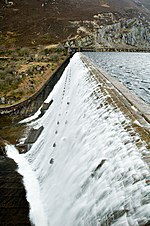Elan Valley Reservoirs

The Elan Valley Reservoirs (Welsh: Cronfeydd Cwm Elan) are a chain of man-made lakes created from damming the Elan and Claerwen rivers within the Elan Valley in Mid Wales. The reservoirs, which were built by the Birmingham Corporation Water Department, provide clean drinking water for Birmingham in the West Midlands of England. The five lakes are known as the Claerwen, Craig-goch, Pen-y-garreg, Garreg-ddu, and Caban-coch.Water from the reservoirs is carried by gravity to Frankley Reservoir in Birmingham via the Elan aqueduct. Pumping is not required because the network drops 52 metres (171 ft) along its 73 miles (117 km) length from its source to Frankley. A gradient of 1:2300 maintains a flow of less than 2 miles per hour (3.2 km/h); water takes one and a half to two days to reach Birmingham. The aqueduct, which was started in 1896 and opened in 1906, crosses several valleys and features numerous brick tunnels, pipelines, and valve houses.Work to build the Elan Valley reservoirs was undertaken because the rapid growth of the industrial city of Birmingham in the late 19th century had led to a lack of available clean water. Numerous outbreaks of disease prompted Birmingham City Council to petition the British government which passed the Birmingham Corporation Water Act in 1892. It allowed the corporation to acquire by compulsory purchase all the land within the water catchment area of the Elan Valleys. Thousands of navvies and their families lived in the purpose-built Elan Village during the construction of the first four dams at the turn of the 20th century. In 1952, the Claerwen dam was opened by Elizabeth II in one of her first official engagements as monarch. Drinking water from the Elan Valley is noted for being exceptionally soft, contrasting with water from local supplies in the West Midlands, not served by the Elan aqueduct, which are noted for hardness.The reservoirs are now owned and managed by Dŵr Cymru Welsh Water. The water filtration works further down the valley is run by Severn Trent Water.
Excerpt from the Wikipedia article Elan Valley Reservoirs (License: CC BY-SA 3.0, Authors, Images).Elan Valley Reservoirs
Geographical coordinates (GPS) Address Nearby Places Show on map
Geographical coordinates (GPS)
| Latitude | Longitude |
|---|---|
| N 52.272222222222 ° | E -3.6888888888889 ° |
Address
Llanwrthwl
, Llanwrthwl
Wales, United Kingdom
Open on Google Maps






